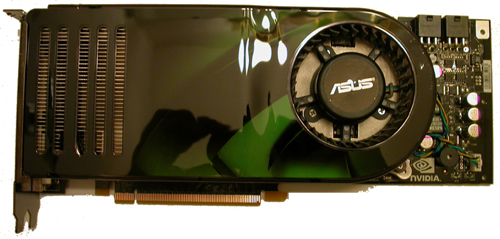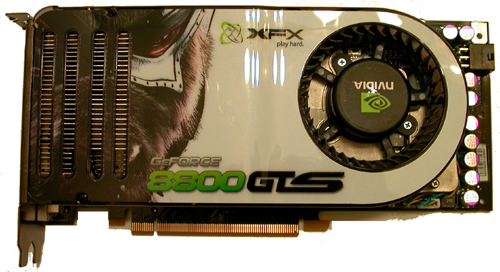GeForce 8800 Roundup: The Best of the Best
by Josh Venning on November 13, 2006 11:04 AM EST- Posted in
- GPUs
Leadtek Winfast 8800 GTX
Moving on we have the Leadtek Winfast 8800 GTX. As is the trend today, we see very little difference between the Leadtek Winfast 8800 GTX and NVIDIA's reference 8800 GTX, aside from the Leadtek graphics stuck to the heatsink. We were able to find prices for many of the cards we have in this review, but the Leadtek Winfast 8800 GTX was one of the few we couldn't find for sale anywhere at the time of publication. Most of the other 8800 GTXs are going for about $650, so once we start seeing this card on the shelf we can expect to see a similar price.

ASUS GeForce EN8800 GTX
ASUS got us its 8800 GTX for our roundup and once again it's a reference card. The design on the HSF of the 8800 GTX we were given is nearly indistinguishable from the reference NVIDIA HSF design, but because we were given very early 8800 samples from manufacturers, small items like graphics and logos on the heatsink will be different for some of these same units when bought off the shelf.

XFX GeForce 8800 GTS
The last 8800 we have for this review is from XFX, and unlike the rest, it happens to be an 8800 GTS. As we mentioned in our launch article, the 8800 GTS runs at lower clocks and has fewer stream processors than the GTX. From a card standpoint, the 8800 GTS is shorter than the GTX and only features a single PCIe power connector.











34 Comments
View All Comments
JarredWalton - Monday, November 13, 2006 - link
It appears Oblivion isn't fully able to use all the SPs at present. The stock 8800 GTX should still have about 17% more potential core performance, although maybe not? If the SPs run at 1.35 GHz, what runs at 575 MHz? Or in the case of the OC'ed GTS, at 654 MHz? It could be they have a similar number of ROPs or some other logic that somehow makes the core clock more important in some cases. Or it could just be that the drivers need more optimizations to make the GTX outperform the GTS in all games. Obviously Oblivion isn't GPU bandwidth limited; beyond that, more testing will need to be done.dcalfine - Monday, November 13, 2006 - link
What about the Liquid-cooled BFG 8800GTX?Any news on that? I'd be interested in seeing how it compared in speed, overclockablility, temperature and power consumption.
Keep up the good work though!
shamgar03 - Monday, November 13, 2006 - link
I ordered one, hopefully it will do well in the over clocking section. I am a bit concerned with the differences in over clocking the cards from different manufacturers. Does anyone know the cause of that? I mean if two cards are the exact same as the reference except for the sticker you have to wonder if there is a bit of a variance in quality of semiconductor production. Maybe favorite distributors get the better cores? Any thoughts on what causes these differences?yyrkoon - Monday, November 13, 2006 - link
I assume this text about the sparkle card is in refference to it's in-ability to overclock ? In my opinion, I would rather use this card, or another card that ran equaly (or better), and remained as cool (or cooler). I dont know about you guys, or anyone else, but the though of a Graphics card approaching 90C (@ load, barring the sparkle) scares the crap out of me, and if this is a sign of things to come, then I'm not sure what my future options are. Lets not forget about 300WATTS + under load . . .
Just as the heat / power consumption is an issue (once again, in my opinion), equally disturbing, is the brass it takes to charge $650 usd, for a first generation, card, that obviously needs alot of work. Yes, it would be nice to own such a card, for pumping out graphics better than anything previous, however, I personally would rather pay $650 for something that ran a lot cooler, and offered just as much performance, or better.
Now, to the guy talking about Vista RC2 drivers from nVidia . . . Do you really expect someone to keep up on drivers, for a "product" that is basicly doomed to die a quiet death ? "RC2" . . . Release candadite . . . as far as I'm aware, the last I checked, alot of the graphics features (of Vista) in these betas were not even implemented. This means, that quite possibly, the drivers between RC2, and release could be a good bit different. Personally, I'd rather have nVidia work on the finished product drivers, VS. the release candadite drivers any day of the week. Aside from yourself, I hardly think anyone cares if you want to run RC2 until May 2007 (legally).
Griswold - Thursday, November 23, 2006 - link
I fail to see your issue with temperatures. These cards were designed to run safely at these temperatures. Just because the figures are higher than you have come used to over the years, doesnt mean its bad.RMSistight - Monday, November 13, 2006 - link
How come the Quad SLI setup was not included on the tests? Quad SLI owners want to know.DigitalFreak - Monday, November 13, 2006 - link
LOL. You really want to see how bad a $1200 setup will get spanked by a single card that costs half as much? You must be a masochist.
penga - Monday, November 13, 2006 - link
Hey, iam always interested in the most exact wattage number a card uses and i find it hard to do the maths from the given total system power consumption and conclude how much only the card eats. So my idea was why not use a mainboard with integrated graphics card and compare the numbers? hope u get the idea. what u think, wouldnt that work?DerekWilson - Monday, November 13, 2006 - link
The only way to do this would be to place extremely low resistance (but high current) shunt resistors in the power lines AND build a PCIe riser card to measure the power supplied by the motherboard while the system is running at load.There isn't a really good way to report the power of just the card any other way -- using an onboard graphics card wouldn't do it because the rest of the system would be using a different ammount of power as well (different cards require the system to do different types of work -- a higher powered graphics card will cause the CPU, memory, and chipset to all work harder and draw more power than a lower performance card).
yyrkoon - Monday, November 13, 2006 - link
Derek, I think he was asking: "why not use an integrated graphics motherboard, as a refference system, for power consumption tests".However, it should be obvious, that this wouldnt be a good idea from a game benchmark perspective, in that, it's been my experience that integrated graphics mainboards dont normally perform as well, and often use dated technology / components. Although I havent really paid that much attention to detail, I would assume you guys use the "best" motherboard, for gaming benchmarks, and probably use the same mainboard for the rest of your tests.